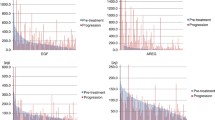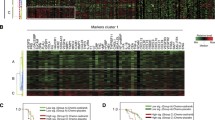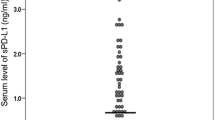Abstract
Purpose
Bevacizumab-based chemotherapy has become the standard of care in metastatic colorectal cancer (MCRC). We aimed to measure the levels of serum soluble FAS, FASL, tumor necrosis factor-related apoptosis-inducing ligand (TRAIL), and its death receptors DR4 and DR5 in MCRC patients and to define prognostic significance of these parameters in response to bevacizumab in these patients.
Patients and methods
The levels of these parameters in serum samples were quantified by a commercially available ELISA kit in 31 MCRC patients before and after 2 cycles of therapy and 25 healthy controls.
Results
Pretreatment sFAS levels in MCRC patients was significantly lower than the levels of controls (p = 0.043). There was no significant difference in sFAS and sFASL levels in MCRC patients before and after bevacizumab-based treatment. There was no significant difference in sFAS/sFASL ratio in MCRC patients before and after treatment and controls. Soluble DR5 levels were significantly higher in pretreatment serum samples compared with controls (p = 0.008). However, pretreatment sTRAIL and sDR4 levels were similar to the levels of controls. There was no significant difference in sTRAIL, sDR4, and sDR5 levels in MCRC patients before and after treatment. When patients were grouped according to treatment response (responders vs. non-responders), post-treatment sFAS/sFASL ratio was significantly lower in responding patients compared with non-responders (p = 0.029). Significant correlations were observed between post-treatment sFASL and sDR4, sFAS and sTRAIL, sTRAIL and sFAS/sFASL ratio, and sFASL and sDR5.
Conclusion
Non-significant changes in apoptotic markers with bevacizumab-based chemotherapy showed that they have no prognostic significance in MCRC patients. Significant change in sFAS/sFASL ratio according to treatment response could be an indicator of chemosensitivity.

Similar content being viewed by others
References
Arase H, Arase N, Saito T (1995) Fas-mediated cytotoxicity by freshly isolated natural killer cells. J Exp Med 181:1235–1238
Cascino I, Fiucci G, Papoff G, Ruberti G (1995) Three functional soluble forms of the human apoptosis-inducing Fas molecule are produced by alternative splicing. J Immunol 154:2706–2713
Cheng J, Zhou T, Liu C, Shapiro JP, Brauer MJ, Kiefer MC, Barr PJ, Mountz JD (1994) Protection from Fas-mediated apoptosis by a soluble form of the Fas molecule. Science 263:1759–1762
Dhein J, Walczak H, Bäumler C, Debatin KM, Krammer PH (1995) Autocrine T-cell suicide mediated by APO-1/(Fas/CD95). Nature 373:438–441
Furuya Y, Fuse H, Masai M (2001) Serum soluble Fas level for detection and staging of prostate cancer. Anticancer Res 21:3595–3598
Furuya Y, Nagakawa O, Fuse H (2003) Prognostic significance of serum soluble Fas level and its change during regression and progression of advanced prostate cancer. Endocr J 50:629–633
Granci V, Bibeau F, Kramar A, Boissière-Michot F, Thézénas S, Thirion A, Gongora C, Martineau P, Del Rio M, Ychou M (2008) Prognostic significance of TRAIL-R1 and TRAIL-R3 expression in metastatic colorectal carcinomas. Eur J Cancer 44:2312–2318
Hefler L, Mayerhofer K, Nardi A, Reinthaller A, Kainz C, Tempfer C (2000) Serum soluble Fas levels in ovarian cancer. Obstet Gynecol 96:65–69
Jemal A, Siegel R, Ward E, Hao Y, Xu J, Murray T, Thun MJ (2008) Cancer statistics, 2008. CA Cancer J Clin 58:71–96
Jodo S, Kobayashi S, Nakajima Y, Matsunaga T, Nakayama N, Ogura N, Kayagaki N, Okumura K, Koike T (1998) Elevated serum levels of soluble Fas/APO-1 (CD95) in patients with hepatocellular carcinoma. Clin Exp Immunol 112:166–171
Kägi D, Vignaux F, Ledermann B, Bürki K, Depraetere V, Nagata S, Hengartner H, Golstein P (1994) Fas and perforin pathways as major mechanisms of T cell-mediated cytotoxicity. Science 265:528–530
Konno R, Takano T, Sato S, Yajima A (2000) Serum soluble fas level as a prognostic factor in patients with gynecological malignancies. Clin Cancer Res 6:3576–3580
Krammer PH (1998) The CD95(APO-1/Fas)/CD95L system. Toxicol Lett 102–103:131–137
Kushlinskii NE, Britvin TA, Abbasova SG, Perevoshchikov AG, Prorokov VV, Kostanyan IA, Knysh VI, Lipkin VM (2001) Soluble Fas antigen in the serum of patients with colon cancer. Bull Exp Biol Med 131:361–363
McCarthy MM, Sznol M, DiVito KA, Camp RL, Rimm DL, Kluger HM (2005) Evaluating the expression and prognostic value of TRAIL-R1 and TRAIL-R2 in breast cancer. Clin Cancer Res 11:5188–5194
Micheau O, Solary E, Hammann A, Martin F, Dimanche-Boitrel MT (1997) Sensitization of cancer cells treated with cytotoxic drugs to fas-mediated cytotoxicity. J Natl Cancer Inst 89:783–789
Midis GP, Shen Y, Owen-Schaub LB (1996) Elevated soluble Fas (sFas) levels in nonhematopoietic human malignancy. Cancer Res 56:3870–3874
Mizutani Y, Yoshida O, Bonavida B (1998) Prognostic significance of soluble Fas in the serum of patients with bladder cancer. J Urol 160:571–576
Mundt B, Wirth T, Zender L, Waltemathe M, Trautwein C, Manns MP, Kühnel F, Kubicka S (2005) Tumour necrosis factor related apoptosis inducing ligand (TRAIL) induces hepatic steatosis in viral hepatitis and after alcohol intake. Gut 54:1590–1596
Nadal C, Maurel J, Gallego R, Castells A, Longarón R, Marmol M, Sanz S, Molina R, Martin-Richard M, Gascón P (2005) FAS/FAS ligand ratio: a marker of oxaliplatin-based intrinsic and acquired resistance in advanced colorectal cancer. Clin Cancer Res 11:4770–4774
Nonomura N, Nishimura K, Ono Y, Fukui T, Harada Y, Takaha N, Takahara S, Okuyama A (2000) Soluble Fas in serum from patients with renal cell carcinoma. Urology 55:151–155
Pan G, O’Rourke K, Chinnaiyan AM, Gentz R, Ebner R, Ni J, Dixit VM (1997) The receptor for the cytotoxic ligand TRAIL. Science 276:111–113
Papoff G, Hausler P, Eramo A, Pagano MG, Di Leve G, Signore A, Ruberti G (1999) Identification and characterization of a ligand-independent oligomerization domain in the extracellular region of the CD95 death receptor. J Biol Chem 274:38241–38250
Perabo FG, Mattes RH, Wirger A, Steiner G, Kamp S, Schmidt D, Pegelow K, von Ruecker A, Müller SC (2001) Soluble Fas and Fas-ligand in bladder cancer in vitro and in vivo. Urol Oncol 6:163–169
Peter ME, Krammer PH (1998) Mechanisms of CD95 (APO-1/Fas)-mediated apoptosis. Curr Opin Immunol 10:545–551
Que FG, Gores GJ (1996) Cell death by apoptosis: basic concepts and disease relevance for the gastroenterologist. Gastroenterology 110:1238–1243
Reipert BM, Tanneberger S, Pannetta A, Bedosti M, Poell M, Zimmermann K, Stellamor MT (2005) Increase in autoantibodies against Fas (CD95) during carcinogenesis in the human colon: a hope for the immunoprevention of cancer? Cancer Immunol Immunother 54:1038–1042
Song E, Chen J, Ouyang N, Su F, Wang M, Heemann U (2001) Soluble Fas ligand released by colon adenocarcinoma cells induces host lymphocyte apoptosis: an active mode of immune evasion in colon cancer. Br J Cancer 85:1047–1054
Spierings DC, de Vries EG, Timens W, Groen HJ, Boezen HM, de Jong S (2003) Expression of TRAIL and TRAIL death receptors in stage III non-small cell lung cancer tumors. Clin Cancer Res 9:3397–3405
Sträter J, Hinz U, Walczak H, Mechtersheimer G, Koretz K, Herfarth C, Möller P, Lehnert T (2002) Expression of TRAIL and TRAIL receptors in colon carcinoma: TRAIL-R1 is an independent prognostic parameter. Clin Cancer Res 8:3734–3740
Tsutsumi S, Kuwano H, Shimura T, Morinaga N, Mochiki E, Asao T (2000) Circulating soluble Fas ligand in patients with gastric carcinoma. Cancer 89:2560–2564
Ugurel S, Rappl G, Tilgen W, Reinhold U (2001) Increased soluble CD95 (sFas/CD95) serum level correlates with poor prognosis in melanoma patients. Clin Cancer Res 7:1282–1286
van Geelen CM, Westra JL, de Vries EG, Boersma-van Ek W, Zwart N, Hollema H, Boezen HM, Mulder NH, Plukker JT, de Jong S, Kleibeuker JH, Koornstra JJ (2006) Prognostic significance of tumor necrosis factor-related apoptosis-inducing ligand and its receptors in adjuvantly treated stage III colon cancer patients. J Clin Oncol 24:4998–5004
Author information
Authors and Affiliations
Corresponding author
Rights and permissions
About this article
Cite this article
Yildiz, R., Benekli, M., Buyukberber, S. et al. The effect of bevacizumab on serum soluble FAS/FASL and TRAIL and its receptors (DR4 and DR5) in metastatic colorectal cancer. J Cancer Res Clin Oncol 136, 1471–1476 (2010). https://doi.org/10.1007/s00432-010-0803-1
Received:
Accepted:
Published:
Issue Date:
DOI: https://doi.org/10.1007/s00432-010-0803-1




